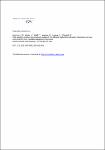CRK adaptor protein expression is required for efficient replication of avian influenza A viruses and controls JNK-mediated apoptotic responses
Hrincius, Eike R.
Wixler, Viktor
Wolff, Thorsten
Wagner, Ralf
Ludwig, Stephan
Ehrhardt, Christina
The non-structural protein 1 (A/NS1) of influenza A viruses (IAV) harbours several src-homology domain (SH) binding motifs that are required for interaction with cellular proteins. The SH3 binding motif at aa212-217 [PPLPPK] of A/NS1 was shown to be essential for binding to the cellular adaptor proteins CRK and CRKL. Both regulate diverse cellular effector pathways, including activation of the MAP-kinase JNK that in turn mediates antiviral responses to IAV infection. By studying functional consequences of A/NS1–CRK interaction we show here that A/NS1 binding to CRK contributes to suppression of the antiviral-acting JNK–ATF2 pathway. However, only IAV that encode an A/NS1-protein harbouring the CRK/CRKL SH3 binding motif PPLPPK were attenuated upon downregulation of CRKI/II and CRKL, but not of CRKII alone. The PPLPPK site-harbouring candidate strains could be discriminated from other strains by a pronounced viral activation of the JNK–ATF2 signalling module that was even further boosted upon knock-down of CRKI/II. Interestingly, this enhanced JNK activation did not alter type-I IFN-expression, but rather resulted in increased levels of virus-induced cell death. Our results imply that binding capacity of A/NS1 to CRK/CRKL has evolved in virus strains that over-induce the antiviral acting JNK–ATF2 signalling module and helps to suppress the detrimental apoptosis promoting action of this pathway.
No license information
Related Items
Show related Items with similar Title, Author, Creator or Subject.
-
2013-03-11ZeitschriftenartikelTowards further reduction and replacement of animal bioassays in prion research by cell and protein misfolding cyclic amplification assays Boerner, Susann; Wagenführ, Katja; Daus, Martin L.; Thomzig, Achim; Beekes, MichaelLaboratory animals have long since been used extensively in bioassays for prions in order to quantify, usually in terms of median infective doses [ID50], how infectious these pathogens are in vivo. The identification of ...
-
2012-12-21ZeitschriftenartikelProtein-Protein Interaction Domains of Bacillus subtilis DivIVA Baarle, Suey van; Celik, Ilkay Nazli; Kaval, Karan Gautam; Bramkamp, Marc; Hamoen, Leendert W.; Halbedel, SvenDivIVA proteins are curvature-sensitive membrane binding proteins that recruit other proteins to the poles and the division septum. They consist of a conserved N-terminal lipid binding domain fused to a less conserved ...
-
2013-08-08ZeitschriftenartikelCytomegalovirus Downregulates IRE1 to Repress the Unfolded Protein Response Stahl, Sebastian; Burkhart, Julia M.; Hinte, Florian; Tirosh, Boaz; Mohr, Hermine; Zahedi, René P.; Sickmann, Albert; Ruzsics, Zsolt; Budt, Matthias; Brune, WolframDuring viral infection, a massive demand for viral glycoproteins can overwhelm the capacity of the protein folding and quality control machinery, leading to an accumulation of unfolded proteins in the endoplasmic reticulum ...

